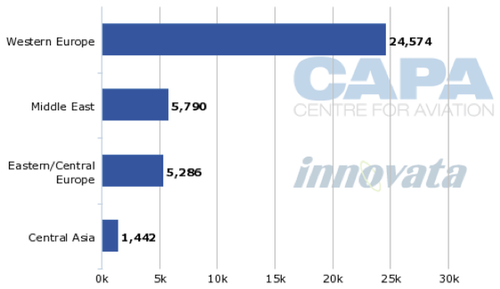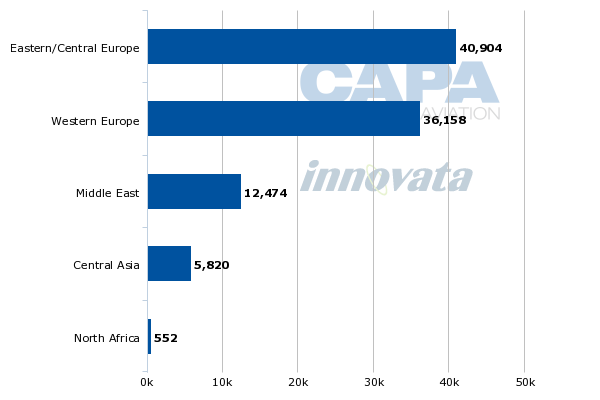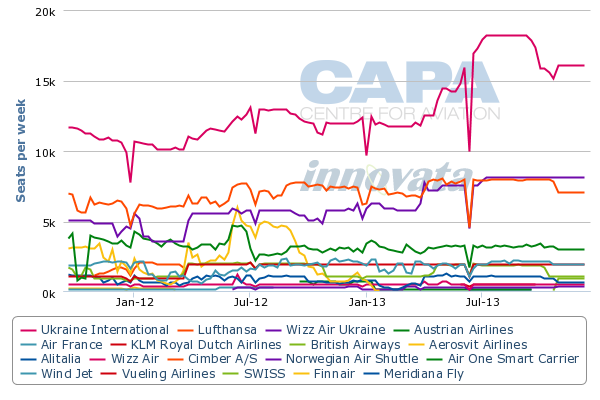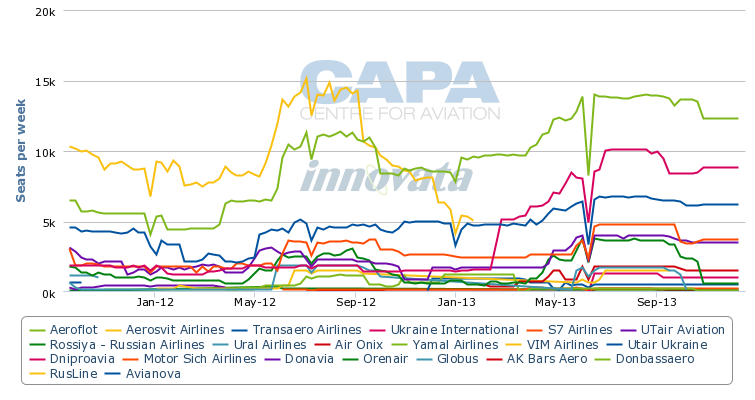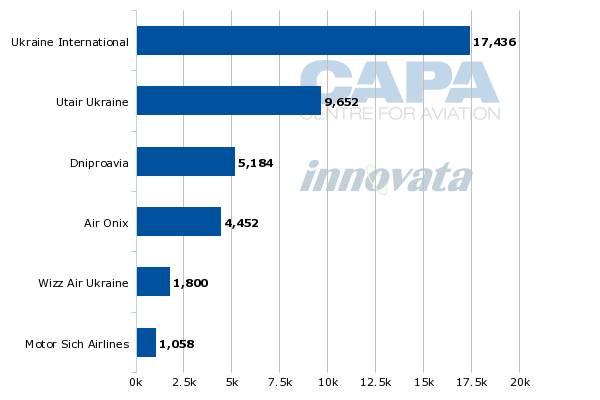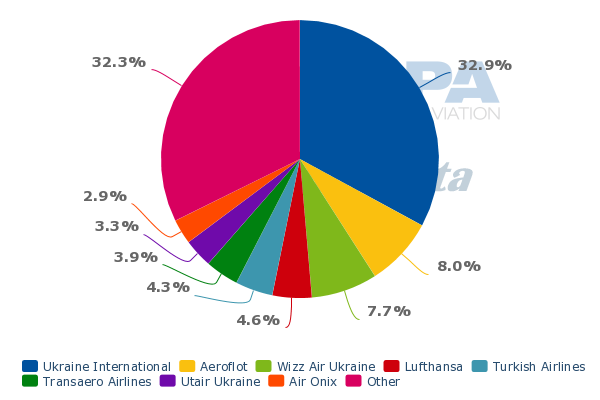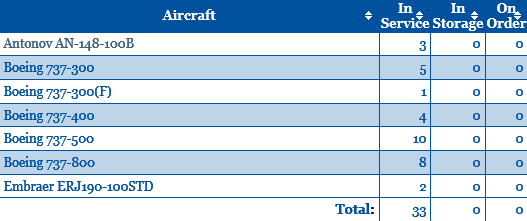Ukraine International Airlines quickly fills the void left by Aerosvit
Ukraine International Airlines (UIA) continues to pursue rapid expansion in an attempt to fill the void left by Aerosvit, which ceased operations in early 2013. UIA is confident it will secure a 40% share of the Ukrainian market by the end of 2013, up from about 32% currently and about 27% prior to Aerosvit's collapse.
UIA and Aerosvit previously had roughly equal shares of the Ukrainian market. The carriers competed vigorously domestically, where each had about a 30% share, but had relatively complementary international networks with limited overlap.
UIA's international network has significantly changed as it has taken over several ex-Aerosvit routes and aircraft. The result is a stronger and more balanced network which for now is focused entirely on short- and medium-haul markets with long-haul expansion a future possibility.
Several smaller Ukrainian airlines have also expanded rapidly following Aerosvit's demise, including low-cost carrier Wizz Air Ukraine. But UIA has benefited the most from the upheaval and has a bright outlook given its now leading position in the market.
UIA capacity increases by 140% in six months
Prior to declaring bankruptcy in late Dec-2012, Aerosvit was the Ukraine's largest carrier with about 52,000 weekly scheduled seats (international and domestic) offered, according to CAPA and Innovata data. UIA was only slightly smaller, with about 48,000 weekly scheduled seats.
UIA has since steadily increased capacity, initially in response to Aerosvit drastically restructuring its network in Jan-2013. Aerosvit attempted after its 28-Dec-2012 bankruptcy filing to retain a domestic operation and about 10 international routes while transferring 30 international routes to UIA.
See related report: Ukraine International to double international network as Aerosvit restructures
But Aerosvit wasn't able to keep its creditors at bay and had to suspend all operations in early Feb-2013. UIA, confident that Aerosvit would not be able to re-launch, further accelerated domestic and international expansion.
In Jul-2013 UIA will provide about 114,000 weekly seats, representing nearly 140% expansion compared to early Jan-2013 capacity levels (before it started to add flights in response to Aerosvit cuts). A portion of the increase, roughly 20,000 seats, is attributable to normal seasonal adjustments as historically all Ukrainian carriers have added a significant amount of capacity for the peak summer season. But a majority of the increase (almost 50,000 seats) is driven by the network and fleet expansion UIA has pursued over the last six months.
Eastern Europe accounts for largest capacity gains at UIA
Most of the Aerosvit routes taken over by UIA were to Eastern European destinations not served by UIA previously. UIA has seen its international capacity within Europe increase eight-fold from about 5,000 seats in early Jan-2013 to about 41,000 seats in Jul-2013.
This is almost entirely driven by growth rather than seasonal fluctuations as UIA had a very limited Eastern European network prior to Aerosvit's collapse. Aerosvit was stronger in Eastern Europe while UIA has traditionally been stronger in Western Europe.
Eastern Europe accounted for almost two-thirds of Aerosvit's international capacity but until early 2013 it accounted for less than 15% of UIA's international capacity. Eastern Europe now accounts for a leading 43% of UIA's international seat capacity.
UIA international capacity (seats) by region: 07-Jan-2013 to 13-Jan-2013
UIA international capacity (seats by region): 8-Jul-2013 to 30-Jun-2013
UIA emerges as new leader in Ukraine to Central Asia and Middle East markets
UIA also has expanded in the Middle East and Central Asia, where it now allocates about 13% and 6% of its seat capacity respectively. The carrier also now serves North Africa but this is a small market accounting for only about 1% of its seat capacity.
UIA previously had a tiny presence in Central Asia, offering only about 1,500 weekly seats. The carrier currently offers about 6,000 weekly seats to and from Central Asia, still a relatively small sum but sufficient to make it the leader in the Ukraine-Central Asia market with a 56% share of capacity.
In this case UIA still hasn't filled the entire void left by Aerosvit, which provided about 8,000 weekly seats to and from Central Asia in Jul-2012. But the total Ukraine-Central Asia market has only decreased slightly as Air Astana has launched services to the Ukraine, with services to Kiev from Almaty and Astana having commenced at the end of Mar-2013.
UIA's Middle East operation also has expanded significantly from a small base. UIA had less than 4,000 weekly seats to and from the Middle East in Jul-2012, giving it about an 18% share of the Ukraine-Middle East market. The carrier now has about 12,500 return seats in the market, giving it a 51% share. Aerosvit previously accounted for almost 40% of capacity in the Ukraine-Middle East market.
UIA and Wizz Air Ukraine fill Aerosvit's void in Western Europe
UIA also took over a few routes to Western Europe, where its capacity has increased over the last six months from about 24,500 seats to about 36,000 seats. On a year-over-year basis, which removes the seasonality factor, UIA's Western European capacity is up about 38% compared to the 26,000 weekly seats offered in Jul-2012.
UIA has seen its already leading share of the Ukraine-Western Europe market grow from 31% in Jul-2012 to 39% in Jul-2013. Aerosvit a year ago accounted for 11% of capacity in this market.
Ukraine to Western Europe capacity by carrier (one-way seats per week): 19-Sep-2011 to 15-Dec-2013
Wizz Air Ukraine has filled the part of the void in the Ukraine-Western Europe market that has not been picked up by UIA. Wizz Air Ukraine will provide about 16,000 weekly seats to Western Europe in Jul-2013, compared to only 11,000 in Jul-2012. As a result its share of capacity in the market has increased from 14% to 18%.
None of the major Western European carriers which serve the Ukraine have taken the opportunity of Aerosvit's exit to increase capacity. Lufthansa is the largest Western European carrier in the market, followed by its sister carrier Austrian Airlines. Air France, KLM, British Airways, Alitalia, Wizz Air, Vueling, Norwegian, Meridiana Fly and Air One also serve the Ukraine but in many cases with a limited number of flights.
Ukraine-Russia market quickly recovers
Eastern European carriers, however, have responded to the opportunity left by Aerosvit. This is not surprising given the strength of Aerosvit in Eastern Europe.
The Ukraine-Russia market has seen the most activity, with significant capacity increases from several Russian carriers and UIA. This is not surprising given Aerosvit had a leading 33% share of capacity in the Ukraine-Russia market and the fact that Russia is the largest international market from the Ukraine, accounting for about one-third of all international seats.
UIA will offer about 22,000 weekly seats to and from Russia in Jul-2013, which represents a huge expansion compared to the only 3,700 weekly seats offered in Jul-2012 and 3,200 weekly seats in Jan-2013. As a result Russia alone accounts for over half of the 36,000 weekly seats UIA has added in the Ukraine-Eastern Europe international market over the last six months.
Aeroflot, which is the largest foreign carrier serving the Ukraine, has increased capacity by around 25% from about 22,000 return seats in Jul-2012 to over 37,000 weekly seats in Jul-2013. Transaero has expanded even more rapidly, growing 50% in the Ukraine from about 9,000 seats to about 13,500 seats. A third Russian carrier, S7, has grown its operation to the Ukraine by about 20% from about 7,000 weekly return seats in Jul-2012 to about 9,500 in Jul-2013.
Ukraine to Russia capacity by carrier (one-way seats per week): 19-Sep-2011 to 15-Dec-2013
The rapid expansion of UIA and the Russian carriers means the large void left by Aerosvit has already been completely filled. In fact total capacity levels between Ukraine and Russia will be up about 13% in Jul-2013 compared to Jul-2012 levels despite the exit of former market leader Aerosvit.
Aeroflot now accounts for a leading 27% of the Ukraine-Russia market, up from 25% a year ago while UIA has seen its share soar from only 4% to 20%. Transaero has grown its share from 10% to 13% and S7 from 7% to 9%. Russian carriers UTair and Rossiya have also grown their shares from 5% to 8% and from 6% to 7%, respectively.
Aeroflot currently accounts for almost 10% of total international capacity in the Ukraine, second only to UIA's 30% share. Transaero and S7 are also among the largest seven international carriers in the Ukraine, accounting for about 5% and 3% of the total international market.
The rest of UIA's spike in Eastern European capacity consists mainly of markets that UIA has entered following the demise of Aerosvit. For example UIA now serves Warsaw and Kaliningrad in Poland and accounts for about 16% of capacity in the Ukraine-Poland market. UIA has filled most of the void in this market left by Aerosvit, which accounted for about 20% of capacity between the Ukraine and Poland.
Aerosvit had been the only carrier linking Vilnius in Lithuania with Kiev. UIA quickly entered this market after Aerosvit's collapse but since then so has Wizz Air Ukraine and UTair Ukraine. UIA currently has a 40% share of capacity in the Ukraine-Lithuania market.
UIA eyes bigger slice of Ukraine's domestic market
UIA has also been able to expand domestically and will provide about 17,000 domestic weekly seats in Jul-2013, up by about 33% from 13,000 weekly seats in Jul-2012. Aerosvit provided up to 19,000 weekly seats in the domestic market during summer 2012, according to CAPA and Innovata data.
UIA now accounts for about 44% of scheduled domestic capacity in the Ukrainian market. Several smaller carriers have also expanded in the domestic market, which continues to be highly competitive despite the withdrawal of one of the two main carriers.
UTair Ukraine is now the second largest domestic carrier with about a 24% share of capacity while smaller Dniproavia and Air Onix account for 13% and 11% respectively. Wizz Air Ukraine, which focuses primarily on the international market, and Motor Sich also currently operate scheduled services within the Ukraine, according to Innovata data.
Ukraine domestic scheduled capacity (seats) by carrier: 8-Jul-2013 to 14-Jul-2013
UIA CEO Yuri Miroshnikov recently told CAPA that the carrier aims to capture 50% of Ukraine's domestic market by the end of 2013. Prior to Aerosvit's collapse, UIA and Aerosvit each accounted for about 30% of the domestic market.
UIA expects further market share gains despite growing competition
Mr Miroshnikov expects UIA's overall or system-wide market share in the Ukraine to reach 40% by the end of 2013 and potentially reach 50% over the medium to long term. UIA's system-wide capacity share in Ukraine will be about 33% in Jul-2013, according to CAPA and Innovata data.
The 50% goal is ambitious given that most of UIA's local competitors are preparing to expand in the international market where, with the exception of Wizz Air Ukraine, they currently have a very small presence. Ukraine's Ministry of Infrastructure recently assigned Ukrainian carriers 60 international routes after 75 applications were filed. Of these, UIA received approval for 24 or 40% of the routes, leaving 36 routes for competitors.
Wind Rose received approval for eight new routes. Wizz Air Ukraine, Aviatrans K and Dniproavia each received approval for six routes. Khors Air, UTair Ukraine and Air Onix each received approval for three routes. Aerocharter received approval for one route.
Of these eight carriers, currently only four operate scheduled services - Wizz Air Ukraine, UTair Ukraine, Dniproavia and Air Onix, according to Innovata data. But the charter market in the Ukraine is huge, with several charter-only carriers and UIA along with other scheduled carriers traditionally having a large charter division. Even if the charter-only carriers do not expand into scheduled services, their expansion into more international markets could impact UIA, including UIA's scheduled operation.
Wizz Air Ukraine is the second largest Ukrainian carrier accounting for about 8% of total scheduled capacity in the Ukraine. UTair Ukraine and Air Onix are much smaller, each accounting for between 3% and 4% of total capacity. Dniproavia has less than a 2% share.
Ukraine system-wide capacity share (% of seats) by carrier: 8-Jul-2013 to 14-Jul-2013
Wizz Air Ukraine, the only Ukraine-based LCC, has increased total capacity in the first six months of 2013 from about 15,000 weekly seats to almost 27,000 weekly seats, according to CAPA and Innovata data. Air Onix and Dniproavia have expanded from very small bases and now offer about 10,000 and 7,500 weekly seats, respectively.
Wizz Air Ukraine is mostly an international carrier and allocates less than 5% of its capacity in the domestic market. Air Onix currently allocates about half of its scheduled capacity to the domestic market while Dniproavia allocates about two thirds of its scheduled capacity domestically.
UTair Ukraine is offering about 11,500 scheduled weekly seats in Jul-2013, which is almost identical to the capacity provided in Jul-2012. But the carrier is expanding its international charter operation. Over 80% of UTair Ukraine's scheduled capacity is domestic. Air Onix and Wind Rose have also been looking at expanding in the international charter market.
Foreign airlines, mainly from the East, expand in the Ukraine
Foreign carriers also have expanded in the Ukraine in time for the peak summer season. With the exception of Italian carriers Air One and Meridiana Fly, which have very small operation in the Ukraine and launched low frequency Catania-Kiev Zhuliany and Olbia-Kiev Boryspil services respectively in Jun-2013, Eastern and Central European carriers are accounting for most of this expansion.
New Eastern European carrier routes launched in Jun-2013 include Kalmata-Kiev from Greece's Aegean Airlines, Istanbul-Simferopo from Turkey's Atlasjet and Baku-Lviv from Azerbaijan Airlines. In Jul-2013, Belarus' Belavia will increase Minsk-Kiev Boryspil frequency from 10 to 12 times weekly.
From the Middle East, flydubai is also planning to increase Dubai-Kiev Boryspil frequency and launch services from Dubai to Dnipropetrovsk and Odessa. flydubai is currently one of just 10 LCCs serving Ukraine.
LCCs currently account for only 14% of total capacity in the Ukraine. UIA, however, is not concerned about increasing LCC competition as the Ukrainian market generally has unfavourable conditions for LCCs including high airport costs. Wizz Air Ukraine has had limited success since launching in 2008 although its outlook and opportunity for expansion improved following the demise of Aerosvit. UIA does not expect a vibrant local LCC sector given the barriers to LCC operations that remain but recognises that Western European LCCs will likely expand in the Ukraine over time.
In the short to medium term UIA is confident it will be able to further grow both its domestic and international market share as more 737-800s and E190s join its fleet. UIA's fleet has already increased from 18 aircraft at the beginning of 2013 to 33 aircraft currently (including three wet-leased aircraft).
Further fleet expansion in 2H2013 is expected with the airline's new E190 fleet set to increase from two to five aircraft and its 737-800 fleet set to reach 10 aircraft. The carrier is seeking additional 737NGs for 2014 and beyond and aims to phase out its fleet of 737 Classics in the second half of the decade. UIA has not placed an order for new aircraft since the 1990s and has been in recent years an opportunistic buyer of second-hand aircraft.
UIA Fleet Summary: as at 28-Jun-2013
UIA expects to replace 737-500s with E190s
Mr Miroshnikov also calls the recent acquisition of five E190s, the first two of which were delivered in 2Q2013, an "opportunistic" move. The aircraft were available and already Ukrainian registered. UIA had a pressing need for additional capacity, making the E190s attractive despite the additional costs associated with adding a new type.
UIA also saw the E190s as a good option for its thinner routes. The carrier expects eventually to have a large E190 fleet as the type will be used to replace its 737-500s, which are expected to be phased out in three to five years.
UIA may also take more E190s in 2014 and 2015 for growth. Mr Miroshnikov says UIA will look at market conditions and how the initial five E190s are performing in UIA's network before deciding on whether to add more E190s for growth. With the Ukrainian market expanding, UIA could decide to instead focus more on growing with 737NGs. But UIA still sees a long-term need for smaller aircraft on some routes.
UIA not yet ready to expand into widebody operations
UIA meanwhile has shelved plans to add widebody aircraft and expand into long-haul services. Prior to Aerosvit's bankruptcy, UIA was planning to add Boeing 777s or A330s in 2013 and start competing with Aerosvit on long-haul services to Asia.
See related report: Ukraine International to expand into long-haul operations in 2013 with Bangkok and Beijing
Mr Miroshnikov says the carrier is now focused on growing its narrowbody fleet given the opportunities in the short and medium-haul markets created by Aerosvit's exit. "We have too much to do with medium range. We don't need to rush," Mr Miroshnikov said.
But UIA could be persuaded to enter the long-haul market in response to moves by local competitors. Wind Rose is planning to start operating long-haul leisure/charter services in the winter 2013/2014 schedule. The charter carrier reportedly is leasing two A330-200 aircraft for services to Bangkok, the Dominican Republic, Goa and Ho Chi Minh City. Bali, Tenerife and Tokyo could be added in summer 2014. UTair Ukraine, meanwhile, is reportedly looking at launching charter services to Bangkok and New Delhi in winter 2013/2014 using Boeing 767s.
Even if no Ukrainian carrier expands into the scheduled long-haul market, UIA risks ceding the long-haul void left by Aerosvit to charter carriers. UIA has contingency options in place for quickly adding widebody aircraft and launching long-haul services should it decide it strategically needs to make a move.
UIA's original plan for competing against Aerosvit to China and Thailand was more strategic than commercial. It would have been nearly impossible for two Ukrainian carriers to compete in such markets without both losing money.
It is challenging to make long-haul operations work from Ukraine on a year-round basis. Aerosvit's overly ambitious long-haul expansion contributed to its demise. UIA should be cautious as the short/medium-haul market is generally more profitable.
UIA in strong position to respond to new competitive threats
2H2013 and 2014 will see more exciting times for Ukrainian aviation as UIA strengthens its position as Ukraine's leading carrier with further capacity and fleet expansion. It will be particularly interesting to see the success other Ukrainian carriers have in entering new international markets, including long-haul markets, and how UIA responds.
With Aerosvit out of the picture, UIA is in the driving seat. The carrier's outlook has significantly improved over the last six months and it now has the muscle to out-manoeuvre any of its smaller remaining competitors.
